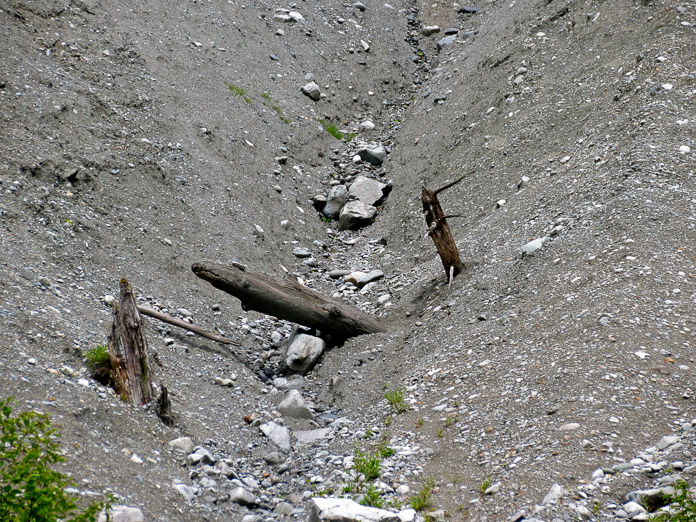
在过去的20,000年里,巨大的冰川冰原已经从Glacier Bay(冰川湾)峡湾前进和消退了很多次。这些树在大约2000年前还在McBride Inlet(马格布莱德湾)区域生长着。在它们还活着的时候,它们被碎石覆盖并且被埋在向前推进的冰层下。在过去的100年间,冰川的消退和侵蚀让它们暴露在空气中并受到风化作用,这导致它们缓慢地腐朽。被特别授权的科学家可以收集这些古老的“间冰期的树木”,利用树木年轮分析和放射性碳定年法来帮助重建Glacier Bay(冰川湾)的冰川消退和增长的序列。
En los últimos 20000 años, enormes campos de hielo han avanzado y se han retirado varias veces del fiordo de Glacier Bay. Estos árboles estaban vivos y crecían en el área de McBride Inlet (ensenada McBride) hará uno 2000 años. Cuando vivían, se cubrieron de grava y fueron enterrados por el avance del hielo. En los últimos 100 años, la retirada del glaciar y la erosión, los han expuesto al aire y al desgaste, lo que hace que se vayan descomponiendo poco a poco. Los científicos con autorización especial para recoger madera de estos “árboles interglaciares”, usan el análisis de anillos y la datación por radiocarbono para intentar reconstruir las secuencias del avance y retroceso glaciar en Glacier Bay.
Enormous glacier icefields have advanced and retreated from the Glacier Bay fjord many times in the last 20,000 years. These trees were alive and growing in the McBride Inlet area perhaps 2000 years ago. While still alive, they were covered by gravel and buried beneath advancing ice. In the last 100 years, the retreating glacier and erosion have exposed them to air and weathering which causes them to slowly decay. Scientists specially authorized to collect the wood of these ancient 'interglacial trees' use tree ring analysis and radio carbon dating to help reconstruct the sequences of glacier advance and retreat in Glacier Bay. Photographer: Elizabeth Flory